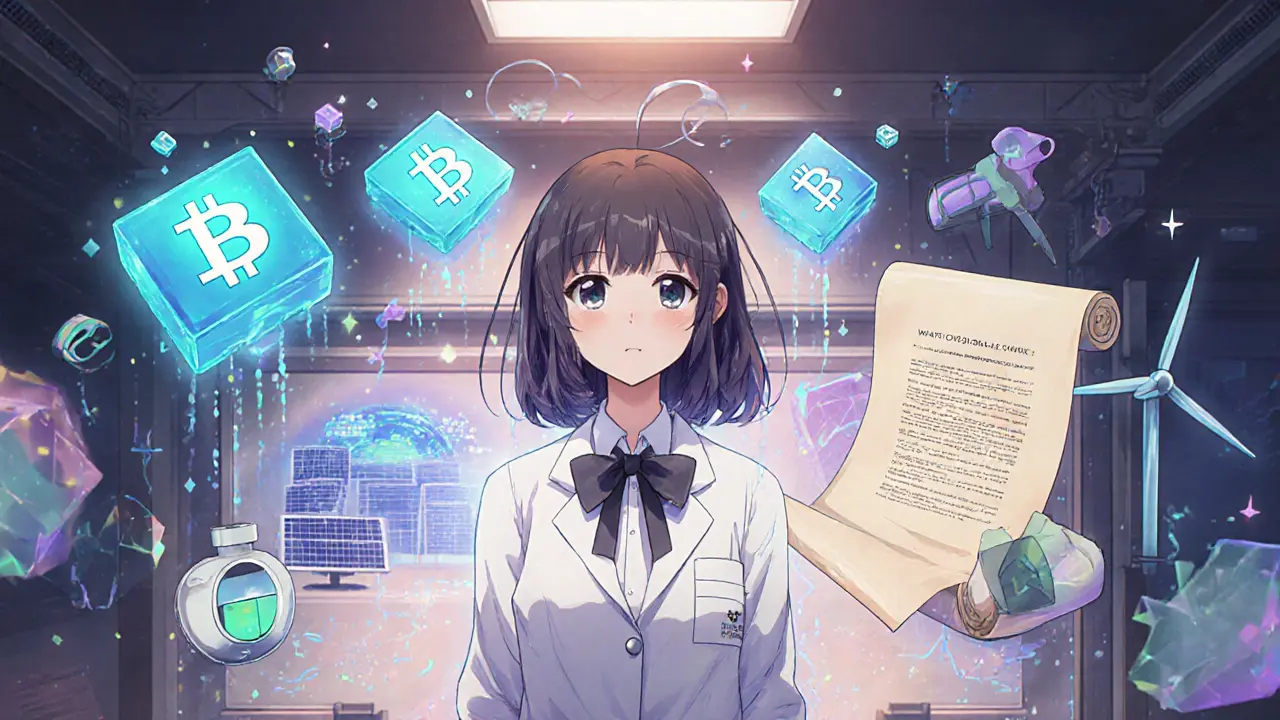How Blockchain Technology is Transforming Microgrids
 Sep, 9 2025
Sep, 9 2025
Blockchain Microgrid Impact Calculator
Estimated Blockchain Impact
Enter values and click "Calculate" to see estimated benefits.
Key Blockchain Advantages in Microgrids
Imagine a neighborhood that can generate, store, and trade its own electricity without waiting for a distant utility. That vision is becoming real thanks to the marriage of microgrids and blockchain technology. This article breaks down what each technology does, how they fit together, and why the combo could reshape the entire energy landscape.
What Exactly Is a Microgrid?
Microgrid is a localized energy network that can operate independently or in sync with the main power grid. It bundles distributed energy resources-solar panels, wind turbines, battery storage, and even backup generators-under a single control system. The core idea is resilience: if the large grid goes down, the microgrid keeps the lights on for its participants.
Blockchain Technology in a Nutshell
Blockchain is a distributed ledger that records transactions in a way that is immutable, transparent, and secured by cryptography. Each block links to the previous one, forming a chain that no single entity can alter without consensus. While most people associate blockchain with cryptocurrencies, its ability to provide trustworthy, tamper‑proof records makes it ideal for many other sectors, including energy.
Key Components Connecting the Two Worlds
The technical architecture that links a microgrid to a blockchain typically includes five building blocks:
- Smart Grid Infrastructure: Sensors, meters, and controllers that monitor voltage, frequency, and power flow in real time.
- Distributed Ledger (the blockchain itself), which records every kilowatt‑hour exchanged.
- Smart Contracts: Self‑executing code that automates settlement and enforces the terms of an energy trade.
- Peer‑to‑Peer (P2P) Energy Trading Platform that lets prosumers buy and sell electricity directly.
- Energy Storage Systems (batteries, flywheels) that balance supply and demand while the blockchain validates each charge‑discharge event.
Each component talks to the others through open APIs, creating a resilient loop where data, control, and finance are all synchronized.

Why Blockchain Makes Microgrids Smarter
Traditional microgrid management relies on a central operator that oversees settlement, verifies metering data, and enforces contracts. Blockchain flips that model on its head:
- Decentralized Control: No single entity dictates the rules. Participants negotiate directly, reducing bureaucracy.
- Full Transparency: Every transaction is visible on the ledger, eliminating disputes over who produced what and when.
- Automated Settlement: Smart contracts instantly transfer digital tokens once a predefined condition-like a certain amount of energy delivered-is met.
- Security and Privacy: Cryptographic signatures protect data integrity while permissioned blockchains can restrict access to sensitive information.
Real‑World Applications
Four practical use cases illustrate how blockchain‑enabled microgrids are already being piloted around the globe:
- Peer‑to‑Peer Energy Trading allows households with rooftop solar to sell excess power to neighbors, creating a local marketplace that operates 24/7.
- Renewable Energy Certificates (RECs) can be tokenized, issued, and tracked on the blockchain, guaranteeing that each certificate truly represents green generation.
- Demand Response programs reward users who shift consumption during peak periods. Smart contracts automatically credit participants based on verified load reduction.
- Green Hydrogen Supply Chains benefit from blockchain‑verified tracking of electrolyzer output, transport, and storage, ensuring the hydrogen remains carbon‑free.
Implementation Considerations
Deploying a blockchain‑powered microgrid isn’t a plug‑and‑play job. Here are the most common hurdles and how operators typically address them:
- Control‑Mode Switching: Moving between islanded (stand‑alone) and grid‑connected modes can cause transient instability. Engineers use advanced droop‑control algorithms and simulations to smooth the transition.
- Scalability of the Ledger: High‑frequency metering data can overwhelm public blockchains. Permissioned or side‑chain solutions keep transaction throughput high while preserving security.
- Interoperability with Legacy Systems: Existing SCADA platforms need adapters that translate IEC 61850 signals into blockchain transactions.
- Regulatory Compliance: Energy markets are heavily regulated. Projects often partner with local utilities to ensure tokenized trades meet market‑operator rules.

Traditional Grid vs. Blockchain‑Enabled Microgrid
| Aspect | Conventional Grid | Blockchain‑Enabled Microgrid |
|---|---|---|
| Control Architecture | Centralized dispatch by utility | Decentralized, peer‑to‑peer coordination |
| Transparency | Limited visibility; data held by utility | Full ledger visibility for all participants |
| Settlement Speed | Hours to days (manual reconciliation) | Seconds to minutes via smart contracts |
| Scalability | Designed for bulk transmission | Flexible; can add new prosumers without re‑engineering |
| Resilience | Vulnerable to wide‑area outages | Islandable; continues operating when main grid fails |
Future Outlook: The Energy Internet
Industry analysts are coining the term Energy Internet to describe a fully interconnected web of microgrids, electric‑vehicle chargers, and IoT devices. In that vision, blockchain acts as the universal protocol for trust, enabling seamless, automated energy swaps across city, regional, and even international borders.
Key trends driving the shift include:
- Rising renewable penetration that requires granular balancing.
- Declining costs of battery storage, making local arbitrage economically viable.
- Regulatory pilots that recognize tokenized energy as a legitimate commodity.
- Advances in machine‑learning‑enhanced cybersecurity, protecting blockchain nodes from attacks.
By 2030, the consensus among researchers is that at least 30% of new distribution projects will embed blockchain from day one.
Quick Takeaways
- Microgrids provide localized, resilient power; blockchain adds trust and automation.
- Smart contracts replace manual settlement, cutting transaction costs by up to 80%.
- Real‑world pilots show P2P trading, RECs, and demand response as the most mature use cases.
- Scalability, regulatory alignment, and control‑mode stability remain the biggest hurdles.
- The emerging "energy internet" could make blockchain‑enabled microgrids the backbone of future power systems.
Frequently Asked Questions
How does a blockchain keep energy transactions secure?
Each trade is signed with a cryptographic private key that only the participant controls. Once recorded, the transaction becomes part of an immutable chain, so anyone trying to alter it would have to rewrite every subsequent block-a computationally infeasible task.
Can existing microgrids be retrofitted with blockchain?
Yes. Most retrofits involve adding a digital meter that feeds data to a blockchain gateway, installing a lightweight node, and deploying smart contracts that match the local market rules.
What’s the difference between a public and a permissioned blockchain for energy?
Public chains allow anyone to join and verify, which boosts transparency but can limit transaction speed. Permissioned chains restrict participation to vetted entities-utilities, regulators, or certified prosumers-offering higher throughput and easier compliance.
Do blockchain microgrids reduce electricity costs for consumers?
Studies from pilot projects in Australia and Germany show average savings of 10‑15% for participants who actively trade surplus energy, mainly because intermediaries are removed and settlement is automatic.
What regulatory challenges should new projects anticipate?
Key issues include licensing of energy traders, compliance with anti‑money‑laundering rules for tokenized assets, and ensuring that blockchain‑based settlements are recognized by local market operators.

Cathy Ruff
September 9, 2025 AT 19:58Blockchain hype in microgrids is just another buzzword.
You think a ledger fixes all the grid headaches?
Think again the reality is messy and costly.
Stay skeptical.
Carthach Ó Maonaigh
September 13, 2025 AT 21:28Holy moly that’s a spicy take, Cathy.
But let’s not throw the baby blockchain out with the bathwater.
Smart contracts can actually shave minutes off settlement times, which matters when you’re juggling solar surplus.
The decentralized nature also keeps the big utilities from pulling the strings.
Bottom line: it’s not a cure‑all but it ain’t dead weight either.
Greer Pitts
September 17, 2025 AT 22:58i totally get the hype and the doubt, it’s a wild mix.
microgrids need something that lets neighbors trade excess juice without endless paperwork.
blockchain could be that friendly middle‑man if we keep it simple.
Lurline Wiese
September 22, 2025 AT 00:28Oh dear, Greer, you’ve just painted a picture worth a thousand suns!
The drama of countless rooftops swapping energy under a transparent ledger is almost cinematic.
Yet, the stakes are high – any glitch could plunge a whole community into darkness.
We must weigh the glamour against the gritty reality of implementation.
Only then can we claim a true revolution.
Jenise Williams-Green
September 26, 2025 AT 01:58Let’s cut through the techno‑optimism and ask who actually profits.
If blockchain turns power into a tradable commodity, we risk commodifying a basic human right.
The “decentralized” narrative often masks new gatekeepers – the token‑issuing platforms.
We should demand community ownership, not corporate cash‑cows.
Otherwise we’re just repainting the same old power structures.
Jim Griffiths
September 30, 2025 AT 03:28Here’s a quick rundown: blockchain can automate settlements, provide audit trails, and reduce admin costs.
Set up a smart contract that triggers when a prosumer’s surplus hits a threshold, and the trade settles instantly.
That’s the core benefit without the fluff.
Matt Nguyen
October 4, 2025 AT 04:58While your summary is serviceable, Jim, it neglects the underlying cryptographic fragilities that pervade public ledgers.
One cannot simply assume “instant” settlement without scrutinizing consensus latency and potential 51% attacks.
Moreover, the data immutability touted as a virtue becomes a liability when erroneous trades are recorded.
One must also consider the opaque influence of mining pools that could subtly steer microgrid economics.
In short, the veneer of elegance hides a labyrinth of technical and geopolitical hazards.
Shaian Rawlins
October 8, 2025 AT 06:28Working with microgrids feels like building a community garden where each house plants its own solar panel and shares the harvest.
When you add blockchain into the mix, you’re giving everyone a transparent ledger to see who contributed what and when.
This transparency builds trust, because neighbors can verify that the energy credits they receive actually came from a real surplus.
Trust, in turn, encourages more people to invest in renewable installations, knowing they’ll be compensated fairly.
The automated smart contracts take care of the paperwork, so you don’t need a middleman to write checks.
That means lower administrative costs and faster payments, which can be reinvested into better batteries or more solar panels.
Because the system is decentralized, no single utility can hijack the pricing or block access.
Local control stays in the hands of the prosumers, fostering a sense of ownership and empowerment.
Moreover, the data recorded on the blockchain can be analyzed to optimize load balancing and reduce waste.
Advanced analytics can suggest when to store energy versus when to sell it back to the grid.
This level of optimization was impossible with traditional, opaque systems.
It also opens the door for innovative business models, like peer‑to‑peer energy swapping or community‑wide demand response programs.
All of these benefits contribute to a more resilient and sustainable energy ecosystem.
Of course, technology is only a tool; the real transformation comes from people willing to collaborate and share resources.
So, if you’re ready to plant those solar seeds, blockchain can be the fertile soil that helps them grow.
Tyrone Tubero
October 12, 2025 AT 07:58Yo Shaian, that was a marathon of good vibes!
But let’s not get carried away – the tech still costs a bundle and can be a pain to set up.
Remember, “transparent” only works if everybody actually reads the ledger.
If they don’t, we’re back to square one with hidden fees.
So hype it up, but keep your feet on the ground.
Taylor Gibbs
October 16, 2025 AT 09:28It’s key to remember that any tech rollout should respect local cultures and existing energy practices.
When communities are involved from day one, the adoption curve smooths out dramatically.
Let’s make sure training and support are part of the plan, not an afterthought.
Rob Watts
October 20, 2025 AT 10:58Totally agree Taylor
We can set up workshops that are chill and hands‑on
People learn faster when they can actually see a transaction on the screen
That way the tech feels less scary and more like a useful tool
Let’s keep the vibe positive and inclusive
Bhagwat Sen
October 24, 2025 AT 12:28Alright folks, let’s dive deep into the nitty‑gritty of consensus algorithms and why they matter for microgrid stability.
If the network slows down, settlement times balloon and prosumers lose trust fast.
Choosing a lightweight protocol like Proof‑of‑Authority can keep latency low, but you trade off decentralization.
It’s a balancing act we need to discuss openly.
Amy Harrison
October 28, 2025 AT 13:58Love the energy, Bhagwat! 😄
We can definitely strike a balance – maybe a hybrid model that uses PoA for daily trades and a more decentralized layer for long‑term contracts.
That way we get speed and security without compromising community control.
Let’s keep the ideas flowing! 🚀
Miranda Co
November 1, 2025 AT 15:28Blockchain won’t fix the grid’s broken policies.
mukesh chy
November 5, 2025 AT 16:58Oh brilliant, Miranda, because nothing screams progress like throwing away a tool that actually reduces transaction friction.
If we ignore blockchain because “policies are broken,” we’ll just be stuck with the same old bottlenecks forever.
Maybe the real fix is to overhaul the regulations, not to abandon the tech outright.
Marc Addington
November 9, 2025 AT 18:28Listen up, this is how real power gets back to the people – by cutting out the foreign tech giants that want to loot our energy data.
We need a home‑grown ledger that’s owned by the community, not some overseas corporation.
If we keep importing their solutions, we’ll never be truly independent.
Amal Al.
November 13, 2025 AT 19:58Marc, I hear your passion for sovereignty!!! However, we must also recognize that open‑source ecosystems can be locally forked and audited, offering security without surrendering autonomy!!! Let’s channel that drive into building a community‑controlled blockchain that respects privacy and fosters resilience!!! Collaboration, not isolation, will empower us most!!!